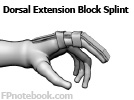II. Epidemiology
- MCP Dislocation is a rare injury
- Most commonly affects thumb or index fingers
III. Mechanism
- Injury is typically due to a direct blow to the finger with secondary hyperextension
- Dislocation at MCP joint is most often at thumb
- Dorsal MCP Dislocation is most common
- However volar and lateral dislocations may also occur
IV. Types of Metacarpal-phalangeal (MCP) Dislocation
- Simple Dislocation
- Dislocation without interposed soft tissue
- Complex Dislocation
- Soft tissue interposed in the joint
- Requires surgical reduction
V. Management: Simple Dislocation
- Precautions
- Avoid reduction by traction (distraction)
- Risk of converting a simple to complex dislocation (interposed tissue) requiring surgical reduction
- Avoid reduction by traction (distraction)
- Anesthesia
- Reduction (dorsal dislocation)
- Flex wrist
- Hyperextend dislocated joint as far as possible
- Push base of proximal phalanx distally
- Bring joint back into flexion while pushing base
- Avoid simple traction (risk of complex dislocation)
- Post-reduction joint assessment
- Assess joint range of motion
- Assess collateral ligaments with MCP flexed
- Imaging to assess joint congruity
- Immobilization for 3 weeks
- Early range of motion and strengthening in uncomplicated dislocations
- Direction of dislocation
- Dorsal dislocation or Lateral Dislocation

- Splint at 30 degrees of flexion at MCP with Dorsal Extension Block Splint for 7-10 days
- Then buddy tape for 2 to 3 weeks and range of motion Exercises
- Volar dislocation
- Splint to maintain extension
- Discuss and refer to local orthopedic consultants
- Dorsal dislocation or Lateral Dislocation
- Finger involved
- Thumb MCP Dislocation: Cast thumb for 3 weeks
- Finger MCP Dislocation: Buddy tape for 3 weeks
- Referral for Lateral Dislocations for any of the following findings
- Delayed presentation >2 weeks
- XRay findings involve >20% of joint surface
- Displacement >2 mm
- Instability (typically of radial collateral ligament with ulnar tilt)
VI. Management: Complex Dislocation
- Reduction usually impossible by closed method
- Joint does not snap back into place
- Joint does not feel reduced
- Reduction prevented by soft tissue in joint
- Surgery usually needed
- Open reduction and internal fixation (ORIF)
VII. Complications
- Volar Plate Injury (dorsal MCP Dislocation)
VIII. References
- Broder (2025) Am Fam Physician 39(9): 22-4
- Childress (2022) Am Fam Physician 105(6): 631-9 [PubMed]
